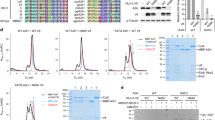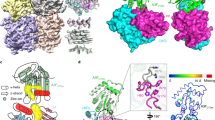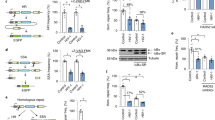Abstract
The human protein apolipoprotein B mRNA-editing enzyme–catalytic polypeptide-like-3G (APOBEC3G), also known as CEM-15, mediates a newly described form of innate resistance to retroviral infection by catalyzing the deamination of deoxycytidine to deoxyuridine in viral cDNA replication intermediates. Because DNA deamination takes place after virus entry into target cells, APOBEC3G function is dependent on its association with the viral nucleoprotein complexes that synthesize cDNA and must therefore be incorporated into virions as they assemble in infected cells. Here we show that the HIV-1 virion infectivity factor (Vif) protein protects the virus from APOBEC3G-mediated inactivation by preventing its incorporation into progeny virions, thus allowing the ensuing infection to proceed without DNA deamination. In addition to helping exclude APOBEC3G from nascent virions, Vif also removes APOBEC3G from virus-producing cells by inducing its ubiquitination and subsequent degradation by the proteasome. Our findings indicate that pharmacologic strategies aimed at stabilizing APOBEC3G in HIV-1 infected cells should be explored as potential HIV/AIDS therapeutics.
This is a preview of subscription content, access via your institution
Access options
Subscribe to this journal
Receive 12 print issues and online access
$209.00 per year
only $17.42 per issue
Buy this article
- Purchase on Springer Link
- Instant access to full article PDF
Prices may be subject to local taxes which are calculated during checkout



Similar content being viewed by others
References
Harris, R.S. et al. DNA deamination mediates innate immunity to retroviral infection. Cell 113, 803–809 (2003).
Mangeat, B. et al. Broad antiretroviral defence by human APOBEC3G through lethal editing of nascent reverse transcripts. Nature 424, 99–103 (2003).
Sheehy, A.M., Gaddis, N.C., Choi, J.D. & Malim, M.H. Isolation of a human gene that inhibits HIV-1 infection and is suppressed by the viral Vif protein. Nature 418, 646–650 (2002).
Simon, J.H.M. & Malim, M.H. The human immunodeficiency virus type 1 Vif protein modulates the postpenetration stability of viral nucleoprotein complexes. J. Virol. 70, 5297–5305 (1996).
Zhang, H. et al. The cytidine deaminase CEM15 induces hypermutation in newly synthesized HIV-1 DNA. Nature 424, 94–98 (2003).
Klarmann, G.J., Chen, X., North, T.W. & Preston, B.D. Incorporation of uracil into minus strand DNA affects the specificity of plus strand synthesis initiation during lentiviral reverse transcription. J. Biol. Chem. 278, 7902–7909 (2003).
Mariani, R. et al. Species-specific exclusion of APOBEC3G from HIV-1 virions by Vif. Cell 114, 21–31 (2003).
Hershko, A. & Ciechanover, A. The ubiquitin system. Annu. Rev. Biochem. 67, 425–479 (1998).
Pickart, C.M. Mechanisms underlying ubiquitination. Annu. Rev. Biochem. 70, 503–533 (2001).
Ma, X.-Y., Sova, P., Chao, W. & Volsky, D.J. Cysteine residues in the Vif protein of human immunodeficiency virus type 1 are essential for viral infectivity. J. Virol. 68, 1714–1720 (1994).
Simon, J.H., Sheehy, A.M., Carpenter, E.A., Fouchier, R.A. & Malim, M.H. Mutational analysis of the human immunodeficiency virus type 1 Vif protein. J. Virol. 73, 2675–2681 (1999).
Yang, X., Gonclaves, J. & Gabuzda, D. Phosphorylation of Vif and its role in HIV-1 replication. J. Biol. Chem. 271, 10121–10129 (1996).
Camaur, D. & Trono, D. Characterization of human immunodeficiency virus type 1 Vif particle incorporation. J. Virol. 70, 6106–6111 (1996).
Fouchier, R.A.M., Simon, J.H.M., Jaffe, A.B. & Malim, M.H. Human immunodeficiency virus type 1 Vif does not influence expression or virion incorporation of gag-, pol-, and env-encoded proteins. J. Virol. 70, 8263–8269 (1996).
Liu, H. et al. The Vif protein of human and simian immunodeficiency viruses is packaged into virions and associates with viral core structures. J. Virol. 69, 7630–7638 (1995).
Margottin, F. et al. A novel human WD protein, h-βTrCP, that interacts with HIV-1 Vpu connects CD4 to the ER degradation pathway through an F-box motif. Mol. Cell 1, 565–574 (1998).
Lama, J., Mangasarian, A. & Trono, D. Cell-surface expression of CD4 reduces HIV-1 infectivity by blocking Env incorporation in a Nef- and Vpu-inhibitable manner. Curr. Biol. 9, 622–631 (1999).
Levesque, K., Zhao, Y.S. & Cohen, E.A. Vpu exerts a positive effect on HIV-1 infectivity by down-modulating CD4 receptor molecules at the surface of HIV-1 producing cells. J. Biol. Chem. 278, 28346–28353 (2003).
Demirov, D.G., Ono, A., Orenstein, J.M. & Freed, E.O. Overexpression of the N-terminal domain of TSG101 inhibits HIV-1 budding by blocking late domain function. Proc. Natl. Acad. Sci. USA 99, 955–960 (2002).
Garrus, J.E. et al. Tsg101 and the vacuolar protein sorting pathway are essential for HIV-1 budding. Cell 107, 55–65 (2001).
Martin-Serrano, J., Zang, T. & Bieniasz, P.D. Role of ESCRT-I in retroviral budding. J. Virol. 77, 4794–4804 (2003).
VerPlank, L. et al. Tsg101, a homologue of ubiquitin-conjugating (E2) enzymes, binds the L domain in HIV type 1 Pr55(Gag). Proc. Natl. Acad. Sci. USA 98, 7724–7729 (2001).
Ward, C.L., Omura, S. & Kopito, R.R. Degradation of CFTR by the ubiquitin-proteasome pathway. Cell 83, 121–127 (1995).
Simon, J.H.M., Southerling, T.E., Peterson, J.C., Meyer, B.E. & Malim, M.H. Complementation of vif-defective human immunodeficiency virus type 1 by primate, but not nonprimate, lentivirus vif genes. J. Virol. 69, 4166–4172 (1995).
Piñol-Roma, S. & Dreyfuss, G. Transcription-dependent and transcription-independent nuclear transport of hnRNP proteins. Science 253, 312–314 (1991).
Acknowledgements
We thank R. Kopito for the kind gift of ubiquitin expression vectors. This work was supported by Research Grants from the UK Medical Research Council (M.H.M.), the Royal Society (A.M.S.) and the National Science Foundation (N.C.G.). M.H.M. is an Elizabeth Glaser Scientist supported by the Elizabeth Glaser Pediatric AIDS Foundation.
Author information
Authors and Affiliations
Corresponding author
Ethics declarations
Competing interests
The authors declare no competing financial interests.
Supplementary information
Rights and permissions
About this article
Cite this article
Sheehy, A., Gaddis, N. & Malim, M. The antiretroviral enzyme APOBEC3G is degraded by the proteasome in response to HIV-1 Vif. Nat Med 9, 1404–1407 (2003). https://doi.org/10.1038/nm945
Received:
Accepted:
Published:
Issue Date:
DOI: https://doi.org/10.1038/nm945
This article is cited by
-
Antiretroviral APOBEC3 cytidine deaminases alter HIV-1 provirus integration site profiles
Nature Communications (2023)
-
Structural basis of HIV-1 Vif-mediated E3 ligase targeting of host APOBEC3H
Nature Communications (2023)
-
Clinical significance of human endogenous retrovirus K (HERV-K) in multiple myeloma progression
International Journal of Hematology (2023)
-
The KT Jeang Retrovirology prize 2022: Florence Margottin-Goguet
Retrovirology (2022)
-
Advances in RNA Viral Vector Technology to Reprogram Somatic Cells: The Paramyxovirus Wave
Molecular Diagnosis & Therapy (2022)



